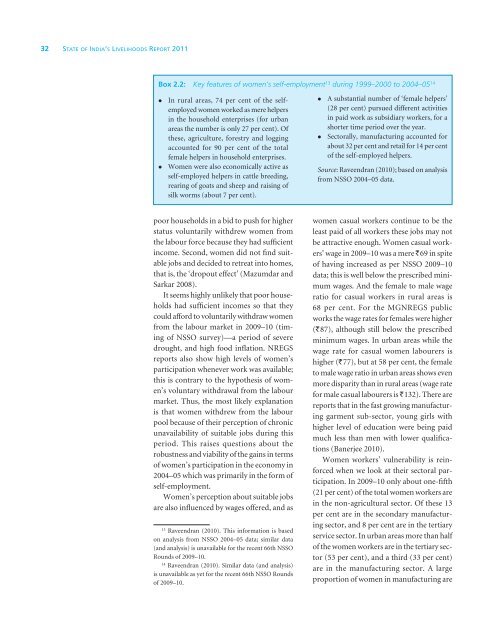SOIL Report 2011 - ACCESS Development Services
SOIL Report 2011 - ACCESS Development Services
SOIL Report 2011 - ACCESS Development Services
- No tags were found...
You also want an ePaper? Increase the reach of your titles
YUMPU automatically turns print PDFs into web optimized ePapers that Google loves.
32 State of India’s Livelihoods <strong>Report</strong> <strong>2011</strong>Box 2.2: Key features of women’s self-employment 13 during 1999–2000 to 2004–05 14• In rural areas, 74 per cent of the selfemployedwomen worked as mere helpersin the household enterprises (for urbanareas the number is only 27 per cent). Ofthese, agriculture, forestry and loggingaccounted for 90 per cent of the totalfemale helpers in household enterprises.• Women were also economically active asself-employed helpers in cattle breeding,rearing of goats and sheep and raising ofsilk worms (about 7 per cent).• A substantial number of ‘female helpers’(28 per cent) pursued different activitiesin paid work as subsidiary workers, for ashorter time period over the year.• Sectorally, manufacturing accounted forabout 32 per cent and retail for 14 per centof the self-employed helpers.Source: Raveendran (2010); based on analysisfrom NSSO 2004–05 data.poor households in a bid to push for higherstatus voluntarily withdrew women fromthe labour force because they had sufficientincome. Second, women did not find suitablejobs and decided to retreat into homes,that is, the ‘dropout effect’ (Mazumdar andSarkar 2008).It seems highly unlikely that poor householdshad sufficient incomes so that theycould afford to voluntarily withdraw womenfrom the labour market in 2009–10 (timingof NSSO survey)—a period of severedrought, and high food inflation. NREGSreports also show high levels of women’sparticipation whenever work was available;this is contrary to the hypothesis of women’svoluntary withdrawal from the labourmarket. Thus, the most likely explanationis that women withdrew from the labourpool because of their perception of chronicunavailability of suitable jobs during thisperiod. This raises questions about therobustness and viability of the gains in termsof women’s participation in the economy in2004–05 which was primarily in the form ofself-employment.Women’s perception about suitable jobsare also influenced by wages offered, and as13Raveendran (2010). This information is basedon analysis from NSSO 2004–05 data; similar data(and analysis) is unavailable for the recent 66th NSSORounds of 2009–10.14Raveendran (2010). Similar data (and analysis)is unavailable as yet for the recent 66th NSSO Roundsof 2009–10.women casual workers continue to be theleast paid of all workers these jobs may notbe attractive enough. Women casual workers’wage in 2009–10 was a mere `69 in spiteof having increased as per NSSO 2009–10data; this is well below the prescribed minimumwages. And the female to male wageratio for casual workers in rural areas is68 per cent. For the MGNREGS publicworks the wage rates for females were higher(`87), although still below the prescribedminimum wages. In urban areas while thewage rate for casual women labourers ishigher (`77), but at 58 per cent, the femaleto male wage ratio in urban areas shows evenmore disparity than in rural areas (wage ratefor male casual labourers is `132). There arereports that in the fast growing manufacturinggarment sub-sector, young girls withhigher level of education were being paidmuch less than men with lower qualifications(Banerjee 2010).Women workers’ vulnerability is reinforcedwhen we look at their sectoral participation.In 2009–10 only about one-fifth(21 per cent) of the total women workers arein the non-agricultural sector. Of these 13per cent are in the secondary manufacturingsector, and 8 per cent are in the tertiaryservice sector. In urban areas more than halfof the women workers are in the tertiary sector(53 per cent), and a third (33 per cent)are in the manufacturing sector. A largeproportion of women in manufacturing are














